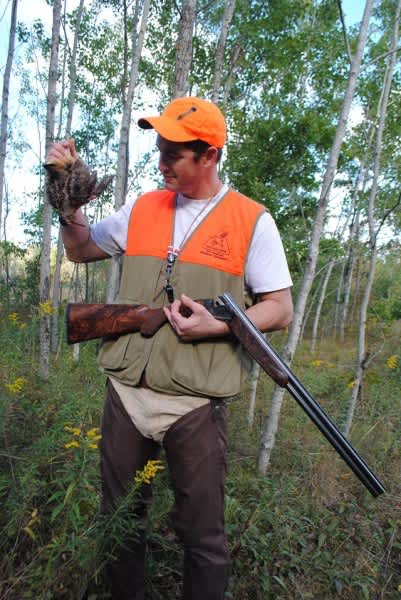Hunting the Thickets for Michigan Woodcock
Bob Gwizdz 10.09.12

We started out in the place where Al Stewart and I have been opening woodcock season in recent years: a low-lying alder thicket along a creek where the ground squishes under your boots as you maneuvered through.
Three things were almost immediately apparent, though. The ground was a lot less squishy than usual, the grass was knee-high on a giraffe, and the woodcock were conspicuous by their absence.
Blame it on the weather this year.
“In those areas that are usually wet or moist soils, there’s usually very little grass or vegetation there,” said Al Stewart, the Department of Natural Resources upland game bird specialist. “In a year like this, when it was dryer in spring and summer, the conditions were favorable for grasses to grow. It becomes really thick in there. That’s not attractive to woodcock.”
Sounds kind of opposite to conventional wisdom, eh? Woodcock generally like habitat as thick as nose tackles’ bellies. But it’s a different kind of thick.
“Woodcock like to be able to see around a little bit,” Stewart said. “They’re found in thick cover but not where ground cover is thick–vertical cover. Like bracket ferns; if you’re standing above it, you can’t see very much, but if you were lying on your belly, you can see quite a distance. That’s a little more attractive to woodcock.”
We followed the creek bottom until Rub, my English setter, started moving off in an upland direction. His bell stopped. We stepped up to find him frozen on point. Stewart’s son Chris was positioned one side of him, I was on the other and Al came up behind him. A woodcock sprang into flight, but his path was quickly intercepted with a load of shot. We were in the plus column.
It set the tone for the rest of the day. We found the bulk of our birds on upland sites. Most of the lowlands were too grassy for the timberdoodles.
Woodcock are sort of poor relations to grouse. They are often found in similar habitat, though grouse are much more highly prized. Ask an upland bird hunter what he’s doing in the aspens and he’ll likely reply “grouse hunting,” even if he’s got woodcock in his game bag.

Woodcock are evolutionarily bizarre birds. They are in the same family as shore birds–to an untrained eye, they look mightily like snipe–but they have adapted to uplands. Their most prominent feature–after their long bills, which they use to probe for subterranean invertebrates–is their large pair of eyes, which are set well back in their heads. One can see that they like to see.
Michigan is the woodcock-huntingest state in the union. Residents of the eastern half of North America, woodcock have been in a long-term population decline. So much so, that the feds (woodcock are migratory birds) are sponsoring a national initiative to improve their numbers.
“Until about three years ago, woodcock had been experiencing a 1.2 to 1.3 percent decline per year since 1968,” said Stewart, who knows these things. “In the last three years that’s kind of leveled out a little more. There’s still a decline, but not as significant as it was just a few years ago.
“We don’t have all the answers yet to say why that decline has leveled off. But it was fairly precipitous until just a few years ago.”
Indeed, the U.S. Fish and Wildlife Service, which oversees woodcock hunting nationally along the same line as it does waterfowl hunting, took action about a decade ago, reducing the length of the season (it used to be 60 days, now it’s 45) and requiring that it open later (the Saturday closest to Sept. 22, it used to open on Sept. 15 as grouse season did).
“It’s not that they’re endangered,” Stewart said. “It’s just something we’re seeing, a point for concern. But they’re not rare. They’re still common.”
Indeed, just minutes later, Rub locked up on point again. This time, however, the bird never flew anywhere where any of us could shoot.
That’s pretty common, too.
The decline in woodcock populations is assumed to correspond to a similar decline in young-aged forests on the landscape. Woodcock prefer habitat with significant stem density. That’s how biologists hope to combat the population downturn.
“We’re focusing in on young forests on our public lands, maintaining the kind of habitat that is good for woodcock and grouse and snowshoe hares,” Stewart said.

And that means aspen, not so much because aspen is the only answer, but it is the most viable economically. Aspen has commercial value.
“What we’re striving for is no nets loss of aspen,” Stewart said. “Aspen provides that core piece that these species utilize. It’s about habitat and social value of young forests; just as we’ve given value to wetlands, to old-growth forests, to grasslands, young forests have been neglected as to people understanding their full value.”
This is so for other species that thrive in early successional forests, too, not just game species. Gold-winged warbler populations, for instance, have been in steep decline as young forest habitat disappeared. Fully a third of American bird species utilize young forests at some point in their lives.
We spent about three hours hunting, working one dog at a time–Chris has a young setter that the Stewarts wanted to run alone–until rain and hail cut our day short. But we flew 16 woodcock (and four grouse). That might be fewer than Stewart and I have flushed in years past. But when you consider our day was cut short and we came up empty in what are traditionally our best spots, it wasn’t too bad at all.
For more information on Michigan hunting go to michigan.org.

